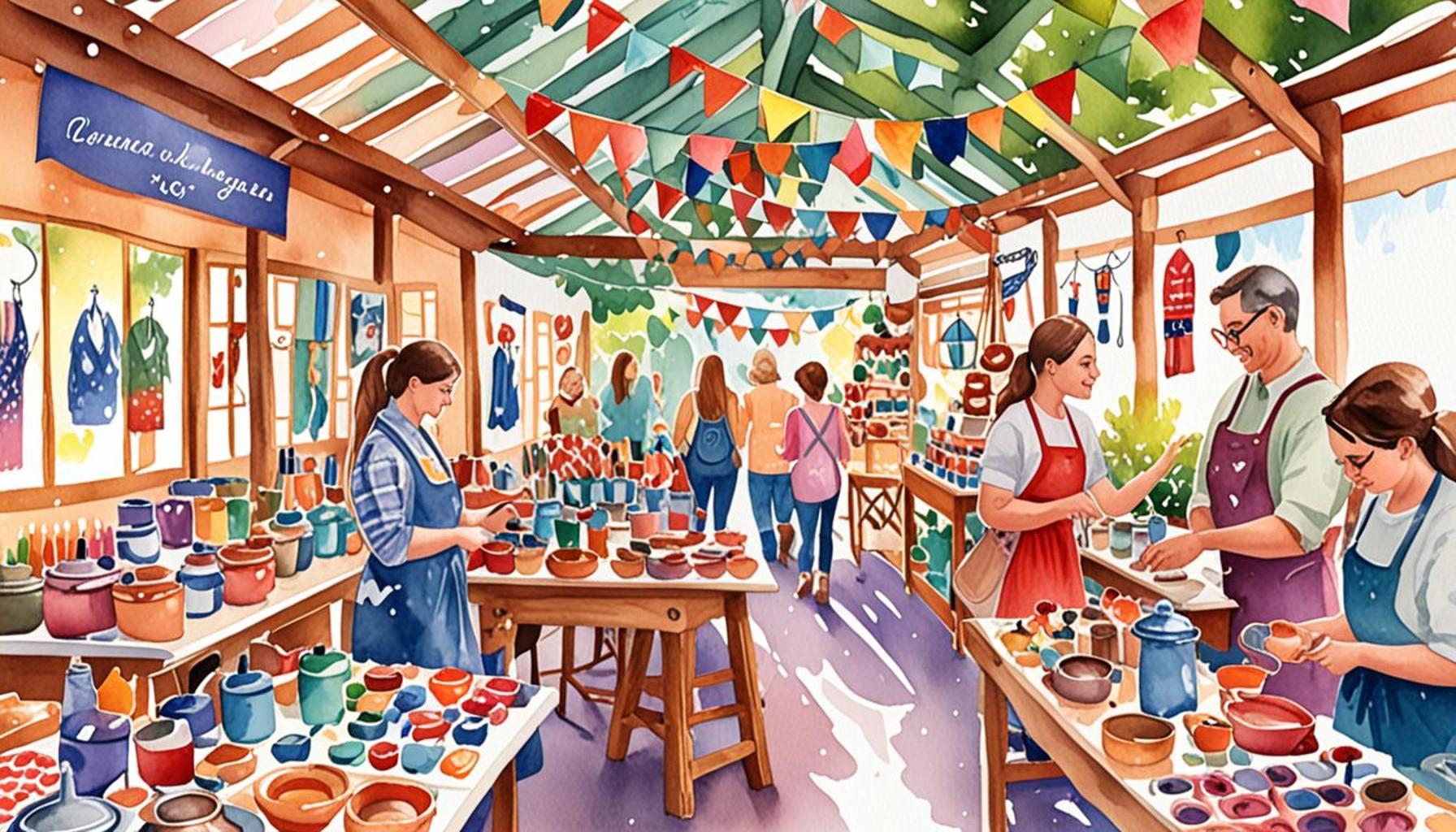Craft Tourism: Discovering Traditional Craft Fairs and Workshops in the USA

Exploring the Diverse Dimensions of Craft Tourism
From the vibrant marketplaces in Santa Fe, known for its Pueblo-style architecture, to the tranquil coastal towns of Maine, craft tourism is evolving into a significant trend across the United States. This enriching form of travel draws enthusiasts into a participatory experience where they can explore and appreciate the local craftsmanship that forms the backbone of many communities. Instead of being passive observers, tourists are invited to engage actively with artisans, learning firsthand about their skills and traditions.
Why should you delve into craft tourism? The answers are as diverse as the crafts themselves:
- Hands-On Experiences: Imagine rolling up your sleeves to create a unique piece of pottery in a local studio, or crafting wooden utensils from reclaimed materials. Workshops often cater to all skill levels, providing a supportive environment for creativity.
- Local Artisans: Engaging with skilled craftspeople offers a glimpse into their lives and practices. For instance, at the American Craft Council shows, visitors can meet artists specializing in everything from jewelry-making to textile arts, sharing their stories and the inspirations behind their work.
- Cultural Immersion: Craft tourism is a gateway to understanding the historical significance of various local arts. For instance, you might discover how the techniques of indigenous beadwork tell stories of heritage and identity, reflecting a deep-rooted connection to the land and community.
Across the nation, an array of craft fairs, workshops, and festivals provide platforms for artisans to showcase their talents. Events like the Prospect New Orleans or the Handmade in America Festival not only celebrate craftsmanship but also create an environment where art is intertwined with local culture. Visitors can purchase handcrafted items that resonate with the spirit of their origin, often at a price lower than retail, while supporting local economies.
Embarking on your craft tourism journey promises not just inspiration from talented artists, but also a deeper appreciation for the dedication it takes to preserve artistic traditions. Every experience contributes to a narrative that enriches your travel adventures while fostering economic sustainability in the communities you visit. So, prepare to uncover the breathtaking artistry and craftsmanship that await—there’s an entire world to explore just waiting beyond the horizon.
DISCOVER MORE: Click here to learn how luxury accommodations enhance your travel experience

Unveiling Opportunities through Craft Tourism
Crafters and travelers alike are finding common ground within the budding phenomenon of craft tourism in the United States. With a plethora of traditional craft fairs and hands-on workshops available, enthusiasts can immerse themselves in the artistic practices that define local cultures. These experiences not only enhance travel but create lasting connections between artists and visitors, emphasizing the importance of supporting and sustaining craft traditions.
Regions across the country showcase unique crafts that reflect their historical, cultural, and environmental influences. Take, for instance, the Shaker furniture-making tradition in the northeastern states, known for its simplicity and functionality. Craft enthusiasts flock to workshops in places like Massachusetts, where they can learn to create their own pieces under the guidance of seasoned artisans. Similarly, in the South, the rich heritage of basket weaving is kept alive by workshops in regions such as South Carolina, where attendees can learn not only the skill but the stories that accompany various techniques.
Among the most notable events in the craft tourism calendar are the vibrant craft fairs that capture the essence of local artistry. Here are a few standout events that invite travelers to engage with craftsmanship:
- American Craft Expo (ACE): This annual event in Evanston, Illinois, brings together over 150 contemporary craft artists showcasing their work in a range of media, from glass to ceramics. Attendees can interact with the artists and purchase unique items directly, supporting the craft community.
- Woodstock-New Paltz Art & Craft Fair: Hosted twice a year in New York’s Hudson Valley, this fair combines art and craft, featuring a diverse array of makers and their creations, including pottery, textiles, and handmade jewelry.
- Ohio Craft Museum’s Annual Holiday Show: Located in Columbus, Ohio, this event highlights local artisans and offers attendees a chance to experience workshops that are perfect for beginners and seasoned artists alike.
Participating in these events grants visitors an opportunity to appreciate the intricacies of traditional crafts, guided by artisans who are eager to share their knowledge and skills. The process of creation is as valuable as the end result, as attendees engage in a deeper understanding of the craft—whether it’s molding clay into a functional art piece or hand-dyeing fabric using natural materials.
In addition to the workshops and fairs, many small towns and cities host pop-up markets and artisan tours that expand the craft tourism landscape. Each event presents a chance to create memorable experiences, interact with local cultures, and discover artisanal techniques passed down generations. With an increasing number of tourists seeking unique, authentic experiences, the demand for craft tourism continues to rise, paving the way for an enriching exploration of America’s diverse artistry.
Exploring Craft Tourism: A Journey Through Traditional Craft Fairs and Workshops
Craft tourism is an enriching experience that offers travelers a unique opportunity to immerse themselves in the vibrant culture of traditional crafts across the United States. This journey not only introduces visitors to fascinating craft techniques but also to the stories and history behind these handmade treasures. From quaint local fairs to interactive workshops, craft tourism highlights the artisans who dedicate their lives to preserving their craft, ensuring the trade is passed down through generations.
Craft fairs are often bustling with activity, featuring a myriad of booths offering everything from handwoven textiles to handcrafted pottery. These fairs serve as a platform for local artists to showcase their work, while visitors can engage directly with the makers, gaining insights into their inspiration and methods. Attending craft fairs provides an opportunity to purchase unique souvenirs that carry local flavor, often supporting small businesses and artisans in the community.
Workshops stand out as interactive experiences where participants can dive deep into crafting skills. Many workshops cater to all skill levels, from beginners curious about woodworking to seasoned crafters looking to refine their techniques in pottery or jewelry making. These classes not only enhance personal artistry but also foster social connections, creating a sense of community among participants who share a passion for creating.
Travelers will also discover that this journey through craft tourism is a chance to explore the local history and culture tied to specific crafts. For instance, visitors to a basket weaving workshop in the Appalachian region may learn about the ancient traditions passed down through native tribes. Participation in these experiences allows travelers to be part of something larger than themselves, connecting with heritage while enjoying the beauty of handmade art.
| Advantages | Details |
|---|---|
| Cultural Immersion | Explore local traditions and interact with artisans. |
| Unique Souvenirs | Bring home one-of-a-kind handcrafted items. |
| Skill Development | Learn new crafting techniques in hands-on workshops. |
| Support Local Artists | Economic boost to small businesses and artisans. |
As you delve into the world of craft tourism, you will unearth stories of craftsmanship that span time and place, enriching your travel experience beyond mere sightseeing.
DIVE DEEPER: Click here for family travel tips
Exploring the Diverse Landscapes of Craft Tourism
The appeal of craft tourism extends beyond mere participation in workshops and fairs. It enriches the traveler’s experience through engaging storytelling and cultural immersion. Each craft carries its own narrative, offering insight into the community’s history, traditions, and values. As travelers venture into the heart of this experiential journey, they uncover the different materials and methods that make each craft distinctive to its region.
One significant aspect of craft tourism is the sustainable practices embedded in traditional crafts. Artisans often utilize locally sourced materials, ensuring not only the authenticity of their work but also fostering environmental consciousness among participants. For instance, in the Pacific Northwest, the craft of salmon leather tanning stands out, where crafters transform discarded skins into elegant accessories. Workshops in towns like Portland allow visitors to learn about eco-friendly practices, emphasizing a connection between traditional skills and sustainable living.
The Traditional Craft Workshop program in San Antonio, Texas, exemplifies a commitment to cultural preservation. This initiative is designed to engage participants in learning traditional Mexican crafts, such as ceramics and textile arts. Here, visitors gain hands-on experience by working side by side with master artisans who share not only techniques but also the narratives intertwined with these crafts. The festival culminates in a showcase, allowing participants to display their creations, fostering a sense of community and shared artistry.
Cultural festivals also play a crucial role in the craft tourism landscape, illustrating the vibrant tapestry of America’s artisanal offerings. For instance, the Renegade Craft Fair held in multiple cities throughout the country, highlights independent makers who expertly blend traditional crafts with contemporary style. This fair emphasizes the evolution of craft, showcasing everything from handmade cosmetics to upcycled furniture, blending the old with the new and attracting a diverse audience.
Furthermore, the rise of craft tourism is evident through a growing interest in regional artisan trails, which create pathways highlighting local crafts and artisans. The Virginia Artisan Trail network leads travelers through various artistic locations, encouraging them to engage with creators directly, while also exploring the breathtaking landscapes of the Blue Ridge Mountains. This initiative promotes not just crafts, but also the local economy, establishing a mutually beneficial relationship between artisans and tourists.
Finally, as technology advances, so does craft tourism. Online platforms have emerged that allow artisans to reach global audiences while still offering local experiences. Virtual workshops, such as those offered by the Craft Institute, bring traditional crafts to a wider audience, breaking geographic barriers and allowing enthusiasts to partake in hands-on experiences from their homes. This blend of tradition and innovation illustrates how the craft tourism industry continues to evolve, ensuring the longevity and relevance of the craft community.
As travelers seek out authentic experiences beyond the conventional tourist attractions, the realm of craft tourism is set to thrive. It offers not just a glimpse of artistic prowess but fosters appreciation, understanding, and connection to regional cultures across the vast landscape of the United States.
DISCOVER MORE: Click here to uncover inspiring literary locations
Conclusion: The Future of Craft Tourism in America
In conclusion, craft tourism offers an enriching avenue for travelers to not only discover the beauty of traditional arts but also to cultivate a deeper appreciation for the stories and histories behind them. As we venture through craft fairs, immerse ourselves in workshops, and engage with artisans across the United States, we unlock a treasure trove of cultural narratives that connect us to the heritage of each region. This burgeoning industry not only celebrates creativity but also intensifies community bonds, pushing forward the conversation on sustainability and environmental ethics through the use of local materials.
The growing integration of technology, such as virtual workshops and online artisan marketplaces, allows more enthusiasts to participate, across all geographic boundaries. This evolution ensures that traditional crafts remain relevant and accessible, fostering a new generation of artisans who can share their skills with the world. As we look to the future, craft tourism appears poised for remarkable growth, inviting more individuals to break away from typical travel experiences and dive into the hands-on allure of artistry.
Whether you find yourself learning the art of pottery in New Mexico, exploring the intricate designs of Native American beadwork, or attending the lively atmosphere of artisan fairs, the essence of craft tourism lies in its ability to transcend mere tourism — it is an opportunity to build connections and impart knowledge that will resonate for generations. Embrace the richness of America’s craft heritage, and consider embarking on your own journey through the colorful world of craft tourism.


